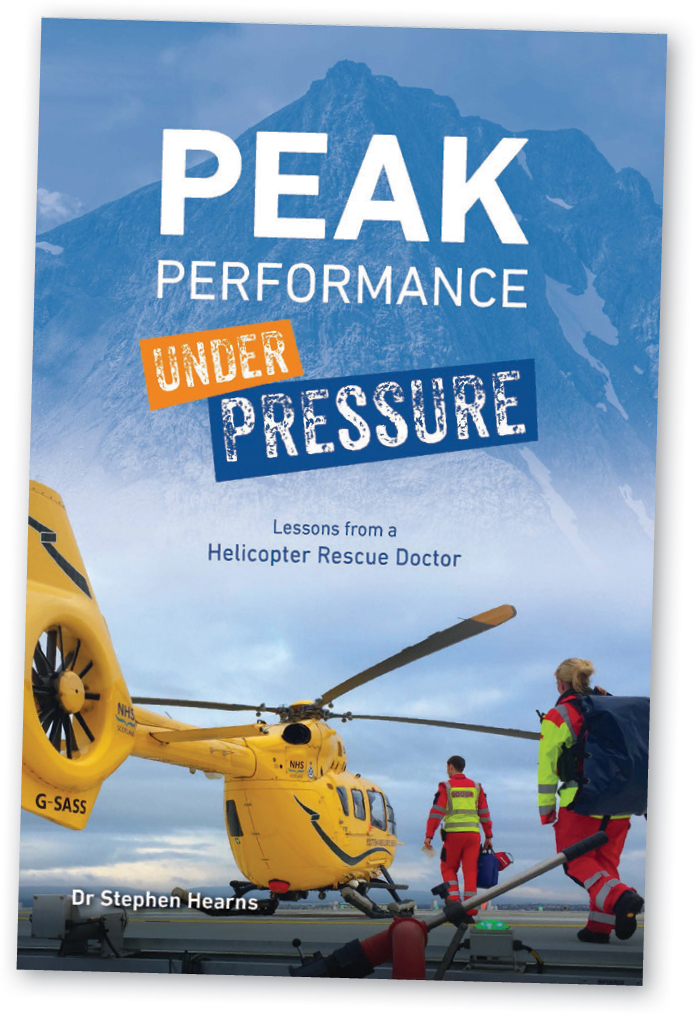
In his book, Peak Performance Under Pressure: Lessons from a Helicopter Rescue Doctor, Dr Stephen Hearns guides the reader through the relationships between performance and pressure, and how these may lead us into three performance states:
You may find yourself in one or more of these performance states depending on how you control the pressure. Hearns offers the reader insights and techniques with which to do this by dividing the discussion into four main categories: the pressure pump, pressure control, pressure testing and pressure relief valves.
Pressure pump
The pressure pump moves the pressure through an organisation. Various internal and external factors can dictate the amount of pressure. Subsequently, how an organisation and its employees manage and deal with this is important.
At a strategic level, this relates to how leadership is delivered and whether a culture of sustainable pressure is supported. Hearns writes that this in turn should promote values, respect, clear objectives and expected standards. At an operational level, we can see how high-functioning ambulance clinicians can be supported within an organisational culture like this. It is also possible to recognise how individuals or groups may enter a state of disengagement or indeed frazzle, if the pressure pump is poorly controlled.
It can, of course, be difficult to reach a consistent level of pressure, especially in larger organisations. To succeed, it is important to have selected a team of highly motivated and experienced people who deliver the strategic aims of your service.
When considering our day-to-day clinical work, ambulance clinicians routinely work autonomously or in small teams. We may control our own pressure pump to allow us the foundation of operating in a flow state when with our patients.
Pressure control
Metacognition or ‘thinking about thinking’ is a theme that the author explores at several stages in his book. How do we organise ourselves to think through high-pressure situations, and why does it matter?
When we are faced with increasing pressure and demands, it can become harder to process information and remember details. Consequently, this may lead to poor performance with a state of frazzle looming and patient care at risk.
Solutions to this often lie in using cognitive aids such as guidelines and checklists. Hearns specifically highlights the importance of JRCALC Guidelines. The JRCALC drug calculation tables are an excellent example of this in helping to offload the need for arithmetic and reduce possibility of drug error when working under pressure.
Checklists are also highlighted as a tool that may assist us when we are thinking through or delivering care to patients. They can help with communication, focusing our team and allowing for a shared mental model. However, they are often not instinctive and require familiarity and, ideally, a second person with which to check and respond.
Examples where checklists may prove beneficial include prehospital thrombolysis, cardiac arrest and return of spontaneous circulation (ROSC) patients among others. The author describes how a well-developed checklist is critical when preparing for high-stakes interventions such as prehospital anaesthesia, blood transfusion or surgical procedures.
Robust pressure control also relies on teamwork. Being able to communicate, lead and cooperate are just some of the traits that Hearns discusses as important to team success. Strategies such as rally points, closed-loop communication and graded assertiveness can be relied upon to maintain a team's momentum and ensure a safe and well-functioning environment for patients.
Pressure testing
Preparation and training can assist us through periods of increased pressure. Through his interviews with emergency services, military, mountain rescue and search and rescue (SAR) personnel, Hearns discusses the value of sustained high-quality training from day one of recruitment, and not just from their first day on shift or deployment.
The benefits of training often parallel with pressure control, as well as testing. The author describes the role of our explicit and implicit memory and how it responds when we are under pressure. The former allows recall of factual knowledge; it is a conscious process but is vulnerable as cognitive demands increase. Implicit memory is embedded through practice and repetition; it is subconsciously accessed, and allows us to complete a task without thinking. When we are under pressure, implicit memory is easier and faster to acquire but calls for thorough preparation through training, drills, mental rehearsal and quality simulation.
Pressure relief valves
Towards his conclusions, Hearns promotes techniques for regaining flow during challenging situations. These are situations where you are experiencing frazzle despite your attempts to manage the pressure, and where you need to regain control and composure.
Controlled breathing and positive inner monologue are well-known strategies advocated by psychologists and athletes that help maintain composure during intense high-demand situations. Hearns recommends that we consider these techniques to regain control of negative emotions or actions brought on by frazzle.
Being able to communicate with colleagues about how you are feeling, delegating tasks and making use of remote support or ‘top cover’ may all assist with releasing the pressure to a manageable level. To be able to articulate what you are thinking, how you are reacting and who can help is evidence of a high-functioning team member, as well as a leader.
Conclusion
Dr Hearns has written a credible, insightful and worthwhile book. The concluding chapter's case studies nicely illustrate how many of the topics discussed assist the author and his colleagues in practice with achieving peak performance while treating critically-ill patients.

